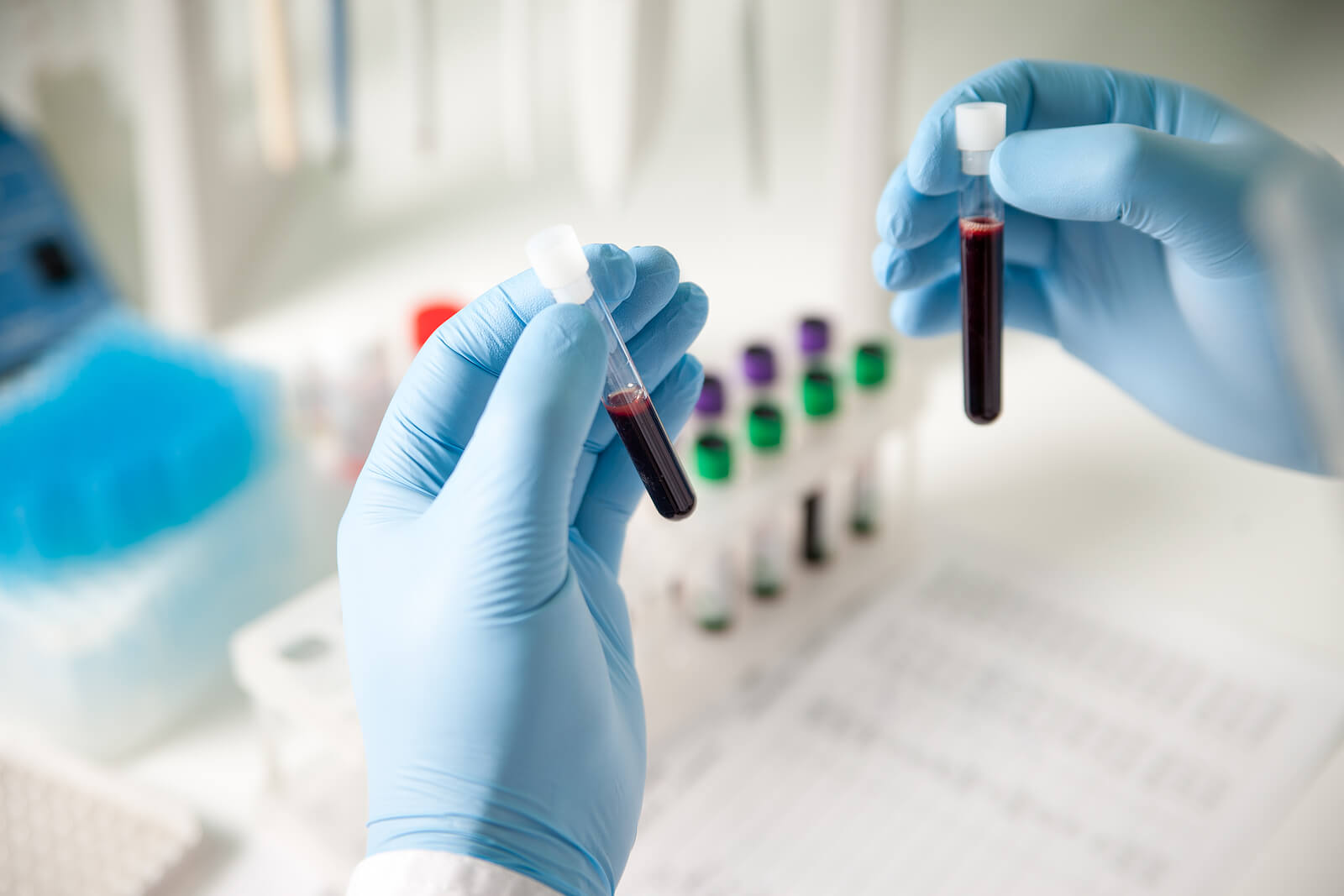Neutropenia: Everything You Need to Know

The white blood cell count is a laboratory test that offers valuable information to medical specialists. These cells must be kept within a certain range and variation outside these levels indicates the presence of some pathology. Neutropenia is a change in a specific type of white blood cell, which can have serious consequences.
White blood cells or leukocytes are the cells in charge of defending the body against the invasion of pathogens. The human body has 5 types of leukocytes, which are divided into polymorphonuclear and mononuclear. Each of these cells will provide specific protection against different pathogens.
Neutrophils and lymphocytes are the most abundant and important white cells in the bloodstream. Neutrophils are polymorphonuclear cells in charge of defense against bacteria (mainly). In this sense, the decrease in these cells can be a sign that something isn’t working properly in the body.
What is neutropenia?
Neutropenia is a laboratory finding that consists of a decrease in neutrophil levels below normal values. These leukocytes should always be at levels above 1.5 × 10 ^ 9 cells per liter or 1500 cells per microliter in adults. For their part, the values should be greater than 1000 cells per microliter in children.
The severity of the disorder and its consequences can vary depending on the number of neutrophils in the blood. In fact, studies show that severe cases increase the likelihood of getting infections from the body’s own bacteria. In this regard, neutropenia can be divided as follows in adults:
- Mild: when the neutrophil count is between 1.0 and 1.5 × 10 ^ 9 cells per liter.
- Moderate: in this case the neutrophils are between 0.5 and 1.0 × 10 ^ 9 cells per liter.
- Severe: when these polymorphonuclear cells have levels less than 0.5 × 10 ^ 9 cells per liter.
Symptoms

This alteration in white blood cells occurs asymptomatically, so people don’t usually notice that they’re suffering from it. Symptoms that can be related to neutropenia appear when an infection is acquired. The main symptom in these cases is fever, which will vary depending on the severity of the condition.
Multiple studies show that people with neutropenia have frequent infections in the respiratory system and gastrointestinal tract. Recurrent infections and bacteria considered as atypical are also very common when you have this problem. With this in mind, people should be on the lookout for the following symptoms:
- Sudden diarrhea
- Abdominal cramps
- Nausea and vomiting
- Cough with expectoration
- Shortness of breath
- The appearance of ulcers in the mouth
- Swelling of the lymph nodes
Causes of neutropenia
Neutropenia can be due to multiple causes, and it can be classified into primary and secondary. Primary neutropenia is very rare and is caused by a defect in bone marrow cells called myelocytes or their precursors. Most of these neutropenias are idiopathic or the result of some genetic disease.
On the other hand, secondary neutropenia is produced by the action of some external factor. The causes of secondary neutropenia are well known in most cases, highlighting the use of certain drugs, some infections, or infiltrative processes of the bone marrow.
Use of drugs and medical treatments
One of the main causes of neutropenia is the use of radiation therapy and some types of chemotherapy to treat cancer. In fact, this alteration is the main side effect of the treatment. The number of neutrophils begins to decline one week after the start of each cycle. However, these cells reach normal values after 3-4 weeks.
In these cases, the decrease in the cell count will be directly proportional to the dose used. In this way, the neutropenia will be more severe if the dose is increased.
Some drugs are capable of reducing the number of neutrophils in the body. This is one of the main causes of the alteration; in fact, it can be responsible for up to 70% of cases according to studies. Among the drugs capable of causing this effect, the following stand out:
- Penicillin G
- Ganciclovir
- Oxacillin
- Methimazole
- Sulfasalazine
- Chlorpromazine
- Quinidine
Infections
Multiple infections can lead to the development of neutropenia by decreasing the production of neutrophils or increasing their elimination. In fact, it’s very common in childhood viral diseases such as dengue. In these cases, the condition appears in the first 2 days of the illness and can last up to 1 week.
A large number of common infectious diseases in adults are also capable of affecting the number of neutrophils in the blood. The human immunodeficiency virus (HIV) is one of the main causes of this occurrence. However, other infections that can cause neutropenia include the following:
- Hepatitis A, B, or C
- Measles
- Chickenpox
- Septicemia
- Salmonella infection
- Epstein-Barr virus
Bone marrow disorders and other diseases
The bone marrow is the main production site for all blood cells, including neutrophils. Therefore, diseases that affect this organ can cause the appearance of neutropenia. In this sense, leukemia, lymphoma, or a metastatic cancer tumor may be the causative agents.
For its part, the spleen is the structure responsible for eliminating neutrophils that have completed their half-life. In this way, an increase in the size of this organ will accelerate cell clearance, lowering the levels of neutrophils and other blood cells. Certain autoimmune diseases such as arthritis or lupus can also be responsible.
Diagnosis of neutropenia

The only possible way to diagnose neutropenia is through a blood test called a complete hematology or complete blood count. It’s a test in which the cells present in the bloodstream are counted, including the polymorphonuclear cells in question. This alteration is usually diagnosed by chance, when blood tests are performed in search of other pathologies.
Specialists should take into account that neutrophil levels vary throughout the day. Thus, a low count on a randomized examination isn’t indicative of neutropenia. The definitive diagnosis should only be made after performing multiple serial analyzes, which should give altered values.
Once neutropenia is diagnosed, doctors will need to identify the cause of the condition. To do this, they must undertake a thorough physical examination, including tests, in search of signs of infection or other diseases.
Additional studies may be necessary to identify the cause of the alteration. In this sense, the doctor can request the measurement of specific antibodies, and even imaging studies. Bone marrow analysis is one of the last options to consider due to the invasiveness of the test.
Treatment
Treatment of neutropenia consists of eliminating the origin. In this way, the neutrophil levels should return to normal. Therefore, it’ll only be necessary to treat the existing infection or eliminate the offending drug to reverse the situation.
There are certain conditions where it isn’t possible to eliminate the cause, this happens in people with HIV or those who receive chemotherapy cycles. In these cases, doctors may recommend the administration of white blood cell growth factors. These drugs stimulate the bone marrow and increase the production of neutrophils, as well as other white blood cells.
People with neutropenia and active infections should take antibiotics to kill the bacteria that are causing the problem. The drugs to be consumed may vary depending on the etiological agent, so they should always be prescribed by a specialist.
A frequent problem that can bring complications
Neutropenia is a very common finding in different diseases, especially those of viral origin. It’s characterized by a decrease in the levels of neutrophils in the blood, which can either be acute or chronic.
Unfortunately, this condition doesn’t have a specific clinical picture, so people don’t notice it until they have complications. Bacterial infections can progress very quickly in these cases and cause severe damage. In this sense, it’s important to see a doctor as soon as possible in the presence of any abnormal symptoms.
The white blood cell count is a laboratory test that offers valuable information to medical specialists. These cells must be kept within a certain range and variation outside these levels indicates the presence of some pathology. Neutropenia is a change in a specific type of white blood cell, which can have serious consequences.
White blood cells or leukocytes are the cells in charge of defending the body against the invasion of pathogens. The human body has 5 types of leukocytes, which are divided into polymorphonuclear and mononuclear. Each of these cells will provide specific protection against different pathogens.
Neutrophils and lymphocytes are the most abundant and important white cells in the bloodstream. Neutrophils are polymorphonuclear cells in charge of defense against bacteria (mainly). In this sense, the decrease in these cells can be a sign that something isn’t working properly in the body.
What is neutropenia?
Neutropenia is a laboratory finding that consists of a decrease in neutrophil levels below normal values. These leukocytes should always be at levels above 1.5 × 10 ^ 9 cells per liter or 1500 cells per microliter in adults. For their part, the values should be greater than 1000 cells per microliter in children.
The severity of the disorder and its consequences can vary depending on the number of neutrophils in the blood. In fact, studies show that severe cases increase the likelihood of getting infections from the body’s own bacteria. In this regard, neutropenia can be divided as follows in adults:
- Mild: when the neutrophil count is between 1.0 and 1.5 × 10 ^ 9 cells per liter.
- Moderate: in this case the neutrophils are between 0.5 and 1.0 × 10 ^ 9 cells per liter.
- Severe: when these polymorphonuclear cells have levels less than 0.5 × 10 ^ 9 cells per liter.
Symptoms

This alteration in white blood cells occurs asymptomatically, so people don’t usually notice that they’re suffering from it. Symptoms that can be related to neutropenia appear when an infection is acquired. The main symptom in these cases is fever, which will vary depending on the severity of the condition.
Multiple studies show that people with neutropenia have frequent infections in the respiratory system and gastrointestinal tract. Recurrent infections and bacteria considered as atypical are also very common when you have this problem. With this in mind, people should be on the lookout for the following symptoms:
- Sudden diarrhea
- Abdominal cramps
- Nausea and vomiting
- Cough with expectoration
- Shortness of breath
- The appearance of ulcers in the mouth
- Swelling of the lymph nodes
Causes of neutropenia
Neutropenia can be due to multiple causes, and it can be classified into primary and secondary. Primary neutropenia is very rare and is caused by a defect in bone marrow cells called myelocytes or their precursors. Most of these neutropenias are idiopathic or the result of some genetic disease.
On the other hand, secondary neutropenia is produced by the action of some external factor. The causes of secondary neutropenia are well known in most cases, highlighting the use of certain drugs, some infections, or infiltrative processes of the bone marrow.
Use of drugs and medical treatments
One of the main causes of neutropenia is the use of radiation therapy and some types of chemotherapy to treat cancer. In fact, this alteration is the main side effect of the treatment. The number of neutrophils begins to decline one week after the start of each cycle. However, these cells reach normal values after 3-4 weeks.
In these cases, the decrease in the cell count will be directly proportional to the dose used. In this way, the neutropenia will be more severe if the dose is increased.
Some drugs are capable of reducing the number of neutrophils in the body. This is one of the main causes of the alteration; in fact, it can be responsible for up to 70% of cases according to studies. Among the drugs capable of causing this effect, the following stand out:
- Penicillin G
- Ganciclovir
- Oxacillin
- Methimazole
- Sulfasalazine
- Chlorpromazine
- Quinidine
Infections
Multiple infections can lead to the development of neutropenia by decreasing the production of neutrophils or increasing their elimination. In fact, it’s very common in childhood viral diseases such as dengue. In these cases, the condition appears in the first 2 days of the illness and can last up to 1 week.
A large number of common infectious diseases in adults are also capable of affecting the number of neutrophils in the blood. The human immunodeficiency virus (HIV) is one of the main causes of this occurrence. However, other infections that can cause neutropenia include the following:
- Hepatitis A, B, or C
- Measles
- Chickenpox
- Septicemia
- Salmonella infection
- Epstein-Barr virus
Bone marrow disorders and other diseases
The bone marrow is the main production site for all blood cells, including neutrophils. Therefore, diseases that affect this organ can cause the appearance of neutropenia. In this sense, leukemia, lymphoma, or a metastatic cancer tumor may be the causative agents.
For its part, the spleen is the structure responsible for eliminating neutrophils that have completed their half-life. In this way, an increase in the size of this organ will accelerate cell clearance, lowering the levels of neutrophils and other blood cells. Certain autoimmune diseases such as arthritis or lupus can also be responsible.
Diagnosis of neutropenia

The only possible way to diagnose neutropenia is through a blood test called a complete hematology or complete blood count. It’s a test in which the cells present in the bloodstream are counted, including the polymorphonuclear cells in question. This alteration is usually diagnosed by chance, when blood tests are performed in search of other pathologies.
Specialists should take into account that neutrophil levels vary throughout the day. Thus, a low count on a randomized examination isn’t indicative of neutropenia. The definitive diagnosis should only be made after performing multiple serial analyzes, which should give altered values.
Once neutropenia is diagnosed, doctors will need to identify the cause of the condition. To do this, they must undertake a thorough physical examination, including tests, in search of signs of infection or other diseases.
Additional studies may be necessary to identify the cause of the alteration. In this sense, the doctor can request the measurement of specific antibodies, and even imaging studies. Bone marrow analysis is one of the last options to consider due to the invasiveness of the test.
Treatment
Treatment of neutropenia consists of eliminating the origin. In this way, the neutrophil levels should return to normal. Therefore, it’ll only be necessary to treat the existing infection or eliminate the offending drug to reverse the situation.
There are certain conditions where it isn’t possible to eliminate the cause, this happens in people with HIV or those who receive chemotherapy cycles. In these cases, doctors may recommend the administration of white blood cell growth factors. These drugs stimulate the bone marrow and increase the production of neutrophils, as well as other white blood cells.
People with neutropenia and active infections should take antibiotics to kill the bacteria that are causing the problem. The drugs to be consumed may vary depending on the etiological agent, so they should always be prescribed by a specialist.
A frequent problem that can bring complications
Neutropenia is a very common finding in different diseases, especially those of viral origin. It’s characterized by a decrease in the levels of neutrophils in the blood, which can either be acute or chronic.
Unfortunately, this condition doesn’t have a specific clinical picture, so people don’t notice it until they have complications. Bacterial infections can progress very quickly in these cases and cause severe damage. In this sense, it’s important to see a doctor as soon as possible in the presence of any abnormal symptoms.
- Dale DC. How I diagnose and treat neutropenia. Curr Opin Hematol. 2016 Jan;23(1):1-4.
- Figueroa L. Neutropenia: un vistazo a su etiología y abordaje clínico. Rev. Colegio de Microb. Quim. Clin. Costa Rica. 2016;22(1):25-33.
- Frater JL. How I investigate neutropenia. Int J Lab Hematol. 2020 Jun;42 Suppl 1:121-132.
- Núñez A, Nordet I, Menéndez A, González A. Neutropenias congénitas. Rev Cubana Hematol Inmunol Hemoter. 2004;20(1).
- Spoor J, Farajifard H, Rezaei N. Congenital neutropenia and primary immunodeficiency diseases. Crit Rev Oncol Hematol. 2019 Jan;133:149-162.
- Dale DC. How I manage children with neutropenia. Br J Haematol. 2017 Aug;178(3):351-363.
Este texto se ofrece únicamente con propósitos informativos y no reemplaza la consulta con un profesional. Ante dudas, consulta a tu especialista.







